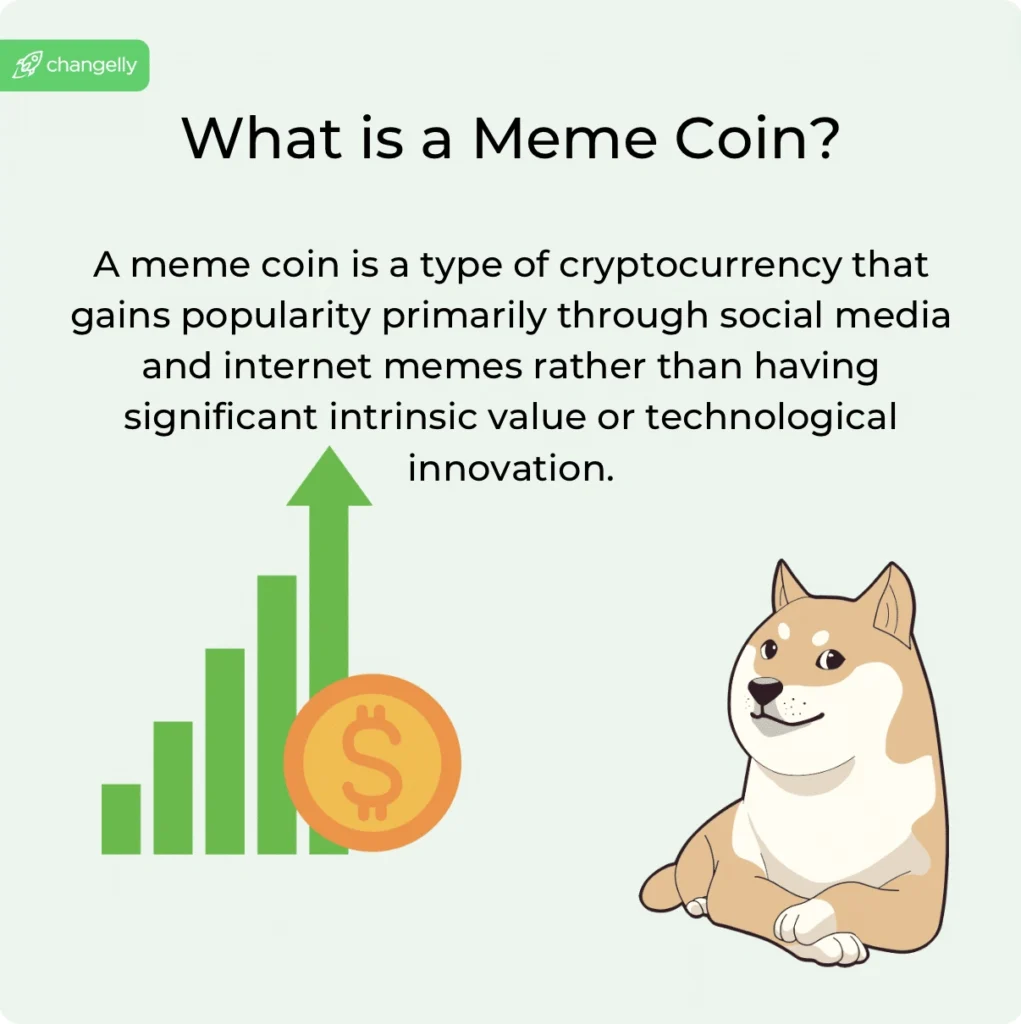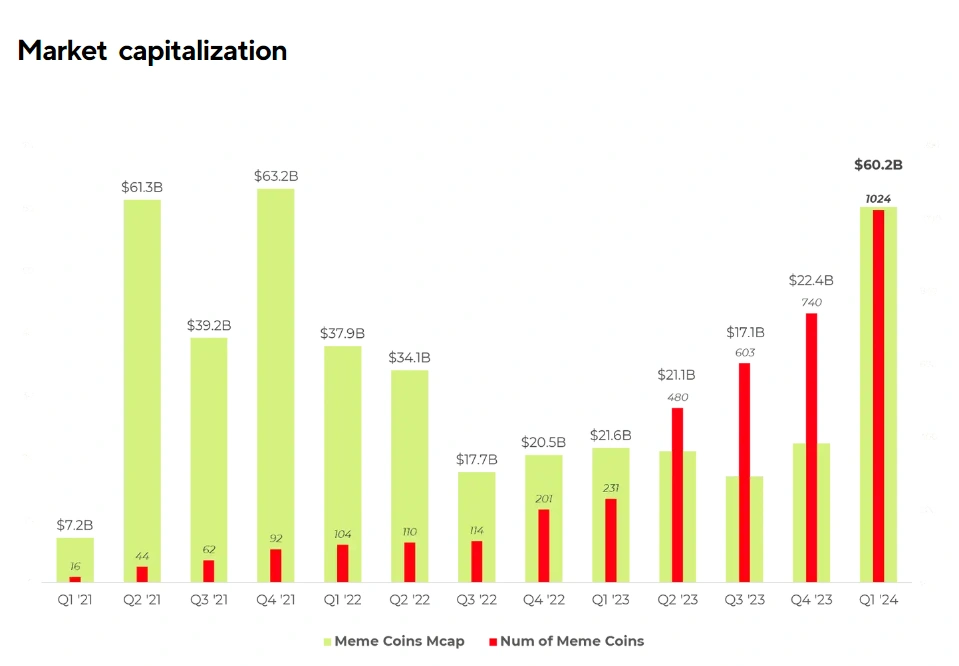The Rise of Meme Coins: What New Investors Should Know
What are meme coins? The term describes a category of cryptocurrencies born out of internet humor, often linked to viral memes or cultural inside jokes. Unlike serious blockchain projects focused on solving real-world problems, meme coin typically begin with satire—yet some grow into billion-dollar tokens with passionate communities and surprisingly active markets.
In 2025, meme coin continue to defy expectations. Their appeal lies not in their technical merits, but in their relatability, internet virality, and the way they resonate with younger, social media-savvy investors.
Meme Coins Explained: From Joke to Juggernaut

Credit from Changelly
The story of meme coins starts with Dogecoin, a cryptocurrency that was launched in 2013 as a parody of Bitcoin. Featuring the Shiba Inu dog from the “Doge” meme, it wasn’t meant to be taken seriously—yet it gained traction for precisely that reason. It was fun, accessible, and oddly sincere in a market full of technical jargon.
Then came Shiba Inu (SHIB) in 2020, branding itself as the “Doge killer.” It introduced more complex features like decentralized exchanges, NFTs, and even its own Layer-2 network, Shibarium. The rise of these tokens marked a shift: meme coins were no longer just internet jokes—they were starting to evolve into entire ecosystems.
A Quick Look at the Meme Coin Timeline
| Meme Coin | Launch Year | Origin Story | Peak Market Cap (USD) |
|---|---|---|---|
| Dogecoin (DOGE) | 2013 | Parody of Bitcoin, Doge meme | $88 billion (May 2021) |
| Shiba Inu (SHIB) | 2020 | “Doge killer” with decentralized goals | $41 billion (Oct 2021) |
| Pepe Coin (PEPE) | 2023 | Based on the Pepe the Frog meme | $1.8 billion (2023) |
| FLOKI | 2021 | Inspired by Elon Musk’s dog “Floki” | $3.5 billion (2021) |
| BONK | 2022 | Solana meme token launched via airdrop | $1 billion (2024) |
These coins owe their growth to social momentum more than technological advancement. While some fizzled out, others managed to sustain communities, raise capital, and even build infrastructure.
Why Meme Coins Remain Popular in 2025
The sustained popularity of meme coins can’t be fully explained by economics or utility. It’s largely psychological and cultural. Investors feel a sense of belonging, humor, and collective identity when participating in meme coin communities.
Social media plays a massive role. Platforms like TikTok, Telegram, and X (formerly Twitter) allow a meme coin to go viral in hours. With humorous branding, user-generated memes, and emotional narratives, these tokens can build momentum quickly—especially when public figures or influencers amplify them.
What also keeps interest alive is accessibility. Many meme coins are priced under a cent, making them appear “cheap” and appealing to retail investors hoping to catch the next 100x opportunity. But it’s worth noting that low price doesn’t mean high value—it’s often a psychological trick more than a financial truth.
How Meme Coins Actually Work
Most meme coins are launched on existing blockchains like Ethereum or Solana. They are typically ERC-20 or SPL tokens that use smart contracts for issuance and trading. While some introduce staking mechanisms, token burns, or redistribution models, most lack complex utility.
Transactions often take place on decentralized exchanges (DEXs) using automated market makers (AMMs). Liquidity can be thin, and price movements can be highly erratic. A few meme coins experiment with community governance through DAOs, but implementation is usually informal or symbolic.
Compared to traditional cryptocurrencies that aim to solve global problems, meme coins often have vague or undefined roadmaps. That said, the creativity around branding and marketing is unmatched. Meme coin projects tend to innovate more in communication than in code.
Investment Potential and Pitfalls
Can meme coins be profitable? Absolutely—but they’re also among the riskiest crypto assets. Prices can surge overnight and collapse just as quickly. Their movements are tied less to technical indicators and more to trends, sentiment, and sometimes celebrity tweets.
Investors should be cautious about “rug pulls,” where anonymous developers abandon projects after draining funds. Many meme coins are launched with minimal transparency or vetting. It’s not uncommon for developers to create hype, list tokens, and vanish with liquidity.
Yet despite the risks, some investors treat meme coin like a lottery ticket—hoping for life-changing gains from a small initial stake. The thrill, community, and narrative pull can be strong motivators, but without an exit strategy or research, losses can pile up quickly.
Meme Coins vs Traditional Crypto Projects
The difference between meme coins and traditional crypto assets is more than just branding. Traditional projects like Ethereum or Solana are built with robust technical goals: smart contracts, decentralized finance, scalable infrastructure. Meme coins are built on momentum.
| Feature | Meme Coins | Traditional Crypto |
|---|---|---|
| Purpose | Humor, virality, speculation | Technology, finance, dApps |
| Utility | Often minimal or meme-driven | Broad and evolving |
| Developer Transparency | Often anonymous | Usually public and structured |
| Risk Profile | Extremely high | Varies by project |
| Longevity | Uncertain | More likely if utility exists |
This isn’t to say meme coin can’t evolve—some are trying. But for most investors, understanding the distinction is essential to managing expectations.
Staying Safe While Investing in Meme Coins
New investors often get caught up in the excitement, only to realize too late that the hype has faded. Safe investing in meme coin requires clear judgment and some basic precautions.
Start by researching the team behind the project—if no information exists, that’s a red flag. Look at the token’s contract, whether it has been audited, and what kind of community it has. Try to avoid echo chambers that promote hype without substance.
Using reliable exchanges also makes a difference. Many meme coins debut on DEXs with limited safeguards. If you do invest, consider setting strict limits and avoiding large positions. Diversifying and using stop-loss strategies can prevent emotional decisions during sudden price drops.
The Meme Coin Scene in 2025: Trends and Outlook
What’s next for meme coins? Several patterns are emerging. Some meme projects are trying to bridge the gap between entertainment and utility by launching NFT collections, enabling tipping on social platforms, or gamifying token ecosystems.
We’re also seeing collaborations with influencers and pop culture figures, turning meme coins into brand extensions. A few are implementing deflationary models—burning coins or reducing supply over time to create scarcity and drive value.
Another rising trend is AI-generated meme tokens, where machine-generated humor drives both the branding and the narrative. These projects blur the lines between creativity, automation, and community-led chaos.
Coins to Watch: Beginner Picks in the Meme Market

Credit from Crypto.com
Dogecoin and Shiba Inu remain the top players in the meme coin arena. Both have staying power and recognizable brands. BONK, launched via airdrop on Solana, is drawing attention for its clever marketing. Pepe Coin continues to ride on meme nostalgia, while newer tokens like Dogwifhat (WIF) are leveraging aesthetics and community memes for momentum.
These coins aren’t guaranteed winners—but they offer a starting point for those curious about meme-based investing.
Conclusion: So, What Are Meme Coins, Really?

Credit from Social Capital Markets
At their core, what are meme coins if not cultural artifacts? They are the crypto world’s response to modern internet culture—chaotic, community-driven, and wildly unpredictable. For new investors, they offer both opportunity and risk, excitement and uncertainty.
Meme coins won’t replace traditional cryptocurrencies, but they’re unlikely to disappear. As long as there are memes and people willing to chase them, meme coin will have a place on the blockchain—part entertainment, part economics, and entirely a sign of the times.




